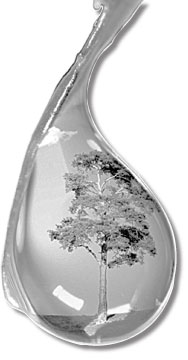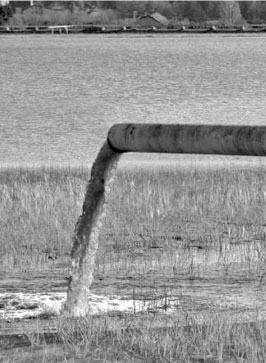|
 Water : Water :
Lifeblood of all beings
by Lal HEWAPATHIRANA
Anuja drew a bucket of water from the little well in the backyard of
his organisation, and poured it into three medium size bottles and kept
them in a cupboard. Being the President of a social service organisation,
headquartered in Madiwela, Sri Jayewardenepura Kotte, which is not so
far away from Colombo, he has been struggling for sometime now, to find
some source of fresh water in the premises suitable for drinking. There
is no pipe borne water supply facility along the road opposite his
headquarters, even though it is a popular bus route leading towards a
well known government hospital. Ultimately he got a little well dug up
to a depth of about 15 metres and drew that bucket of water gleefully,
as he found the colour very similar to the water he gets from his well
at home in Boralesgamuwa.
On the following day, Anuja observed that the water in all three
bottles had turned somewhat brownish. On the next day, it was worse with
the colour becoming darker, and the following day water was incredibly
dark brown. Why is this? He started wondering. In an area densely
populated, after all it has been named the capital of the country, how
could the water found a mere 15 metres below the surface of the earth be
so bad? After nearly a month, Anuja is still trying to find a plausible
answer!
Not only in Madiwela of Sri Lanka, but the world over, the problem is
the same. In the global context, one out of every eight people lacks
access to clean water. Each year, 3.3 million persons die due to water
related health problems. According to the reputed National Geographic,
97.5 percent of the water on earth is salty, and around one percent of
that is brackish groundwater. Only 2.5 percent of the earth’s water is
fresh, but about two-thirds of that is frozen. The rest is liquid
surface water and groundwater.
Proper hygiene
Renowned environmental journalist Tina Rosenberg says that in wealthy
parts of the world people turn on the faucet and out pours clean water.
Yet nearly 900 million people in the world have no access to clean
water, and 2.5 billion people have no safe way to dispose of human waste
- many defecate in open fields or near the same rivers they drink from.
Dirty water, and lack of a toilet and proper hygiene kill 3.3 million
people around the world annually, most of them children under age five.
 The World Water Council (WWC) confirms this data with still more
shocking information. “An estimated 1.1 billion people already live
without clean drinking water,” states a WWC Report. “Over 2.6 billion
people lack adequate sanitation. Over 1.8 million people die every year
from diarrhoeal diseases, and 3,900 children die each day from
water-borne diseases,” the report adds. The World Water Council (WWC) confirms this data with still more
shocking information. “An estimated 1.1 billion people already live
without clean drinking water,” states a WWC Report. “Over 2.6 billion
people lack adequate sanitation. Over 1.8 million people die every year
from diarrhoeal diseases, and 3,900 children die each day from
water-borne diseases,” the report adds.
While this scenario is taking place elsewhere in the world, another
international water conference was held a few days ago in Stockholm,
with the participation of over 2500 water experts, to remind the world
that water issues should be addressed promptly or be prepared to face a
devastating immediate future engrossed with pollution, diseases,
droughts, floods, scarcities and even desertification.
It was not so long ago that our own Meteorology experts warned us of
impending natural disasters of a serious nature. We were told that
climate change is causing weather-related natural disasters, and we,
being a tropical country, are vulnerable to them.
The recent chain of natural disasters that took place around the
world, be it the West, East. North or South, is adequate proof of that
warning. An International Red Cross Report refers to a concept called
Hydro-meteorological Disaster, which is disaster caused by the
combination of water and weather related factors. The report points out
that during the period 1996 to 2007, nearly three billion people the
world over were affected by disasters, and out of them 98 percent were
due to hydro-meteorological disasters such as flash floods, tsunamis,
cyclones and droughts.
Fresh water
The old pronouncement of the environmentalists still holds good even
in the 21st century, which is that ‘There is no shortage of water on the
blue planet - it is just a shortage of fresh water’. The assessment is
that three hundred million people now get their water from the sea or
from brackish groundwater that is too salty to drink. That seems to be
double the number in the year 2000. The reason for the boom is well
known - the ever increasing population and the expansion of agriculture
and industry. One-third of the available water is consumed by the
people, and the remaining two-third is used to grow food. With 83
million more people on earth each year, water demand will keep
escalating, and the solution to the problem remains in our efforts to
change how we use water.
Being a chemical compound with a simple chemical process of two atoms
of hydrogen joined to one atom of oxygen, water comes to us from
different sources such as groundwater or surface water in rivers and
reservoirs. Desalination of sea water is a process that came into being
in the 1970s in the Middle East region. It has since spread to over 150
countries and the reports say that within the next six years this
process will still keep widening to contribute as much as 13 billion
gallons a day to the global supply of water, as pointed out by National
Geographic.
Water is life for all living beings, including plants. It makes up
two-third of our bodies, just like the map of the world. Our vital
fluids are saline, like the ocean. Our civilisations started on the
banks of mighty rivers, and have survived for hundreds of centuries -
thanks to water. However, now and in the future, our most dreadful
thought lies in the thread of having too little or too much of it in the
form of droughts or floods. Water, our eternal friend, thus becomes a
foe to us. The traditional foe of water quality itself is waste from
factories and farms.
Climate change
Water is the visible face of climate and therefore climate change,
according to scientists. Shifting rain patterns flood some regions and
dry up others. Hot air holds more water molecules than cold air. On top
of Himalaya, glaciers whose melted water sustains vast populations are
dwindling. The past decade has brought us more extreme storms than ever
before. Besides, glaciers in the heart of Asia feed its greatest rivers,
the lifeline for two billion people. Now the ice and snow are melting.
These are all disastrous.
“Unlike petroleum, water will always be with us”, writes Barbara
Kingsolver, and she states, “Our trust in earth’s infinite generosity
was half right, as every raindrop will run to the ocean, and the ocean
will rise to the firmament. And half wrong, because we are not important
to water. It’s the other way around.”
Barbara’s perceptions are fully justified by some of the startling
facts revealed recently also by the National Geographic. It says that
Americans use about 100 gallons of water at home each day, whereas
millions of the world’s poorest subsist on fewer than five gallons.
Also, 46 percent of the people on earth do not have water piped to their
homes. Women in developing countries walk an average of 3.7 miles to get
water. Most alarming is the final projection, which is that in 15 years
time, 1.8 billion people will live in regions of severe water scarcity.
 |
|
Pollution of water
sources |
Future projections of the water experts of the world are phenomenal
in a way, and horrifying in another. In a book titled ‘Water Wars’
written by Marq Villiers a decade ago, he says, “There is certainly
enough water for every person on the planet. But, too often it is in the
wrong places, at the wrong times, and in the wrong amounts.”
Another school of thought believes that there is plenty of usable
water in circulation on earth to sustain its 6.5 billion inhabitants -
the estimated requirement being about 40 million cubic kilometres.
Assessing that the 6.5 billion people will need only an estimated 8,000
cubic kilometres out of that 40 million, they say that there would be
plenty of water. But the others do debate on this point. They argue that
estimates vary. Thus, 5 to 10 percent of all water consumed is needed
for human drinking, cooling, bathing, and sanitation needs, while
industry requires another 10 to 20 percent and agriculture the largest
slice of 70 to 85 percent. With the future increase in population as
well as human activity, these percentages will escalate, is their
argument.
In 1999, a special committee of the United Nations comprising 200
scientists from 50 countries identified water scarcity as one of the two
major problems of the world in the new millennium. At the UN Millennium
Summit in 2000, 147 world leaders adopted the target of 2015 to reduce
by 50 percent the proportion of people unable to access safe drinking
water.
UN proceeded further by declaring 2003 as the Water year or the
International year of Freshwater. Accordingly, 2015 - the year of hopes
for 1.1 billion poor people of the world, who have been denied access to
clean drinking water so far, is only four years away from them.
Has the UN achieved what it promised or rather agreed at those
multifaceted global assemblies? At least why doesn’t the UN take stock
of how far or how close it is to its targets by 2010, and tell the world
about it?
|

